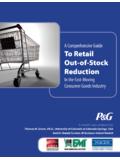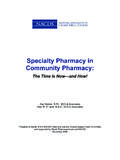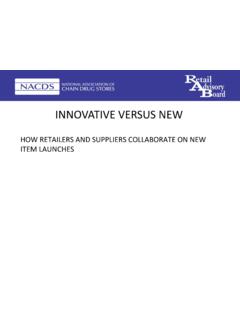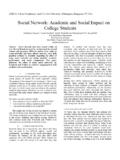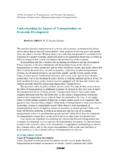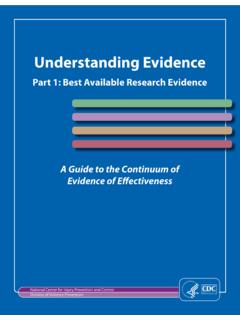Transcription of Understanding the Drivers of Expired …
1 Understanding the Drivers of Expired pharmaceutical Returns1 Understanding the Drivers of Expired pharmaceutical Returns2 The Healthcare Distribution Management Association (HDMA) is the national association representing primary, full-service healthcare distributors. Each business day, the member companies of HDMA are responsible for ensuring that more than eight million prescription medicines and healthcare products are safely delivered to 145,000 pharmacies, hospitals, nursing homes, physician offi ces, clinics, government and other providers in all 50 states. This essential public health function is provided with tremendous effi ciency, saving the nation s healthcare system nearly $32 billion each year. HDMA and its members are the vital link in the healthcare system, working daily to provide value, remove costs and develop innovative solutions to deliver care safely and in this report, Understanding the Drivers of Expired pharmaceutical Returns, are intended to help distributors, manufacturers, healthcare providers and service providers identify opportunities to improve inventory management and ultimately reduce the volume of Expired returns in the reverse supply chain.
2 All stakeholders involved in the project have a shared vision to reduce total supply chain costs associated with unsaleable returned goods while preserving or improving the safety and security of the healthcare supply report identifi es several product-related and demand-related Drivers of Expired pharmaceutical returns. This report also contains examples of process improvements that may help companies address and reduce the quantity of Expired products returned, as well as track their progress in making these improvements. Moving forward, the adoption of track-and-trace technologies may enable companies to have more control in managing inventory and ultimately limit the volume of Expired pharmaceutical returns. A company may wish to consider using the information in this report in its own, individual business practices or in conjunction with its trading partners in order to reduce the quantity of report and its associated project are key components of HDMA s vision and ongoing efforts to promote enhanced data sharing within the healthcare supply chain.
3 These efforts are part of an overall strategy to advance best business practices and improve supply chain security and patient the Drivers of Expired pharmaceutical Returns3 Developed for theReturns Task ForcePrepared byMay 2009 Project SupportersHDMA would like to extend our appreciation to the supporters of this project: Understanding the Drivers of Expired pharmaceutical ReturnsReducing the Quantity of Expired Pharmaceuticalsin the Healthcare Supply ChainRUnderstanding the Drivers of Expired pharmaceutical Returns4 Understanding the Drivers of Expired pharmaceutical Returns5 Copyright 2009 by Healthcare Distribution Management Association, United States. All rights reserved. This publication may not be reproduced, stored in any informational retrieval system or transmitted in whole or in part by any means electronic, mechanical, photocopying, recording or otherwise without the express written permission of the Healthcare Distribution Management Association (HDMA). ISBN: 978-0-9802095-9-4 Understanding the Drivers of Expired pharmaceutical Returns OVERVIEW HDMA RETURNS TASK FORCE PROJECT TEAM INTRODUCTION THE OPPORTUNITY INVENTORY VISIBILITY RETURNS Drivers : SUMMARY RETURNS Drivers : DETAILS APPENDIX A: LEADERS IN RETURNED GOODS MANAGEMENT APPENDIX B: IMPACT AND DIFFICULTY OF RETURNS Drivers APPENDIX C: INDUSTRY PROJECTION FOR VALUE OF Expired Rx RETURNS 6678891012232526 Understanding the Drivers of Expired pharmaceutical Returns6 OVERVIEWThis report describes the major causes that contribute to unsaleable pharmaceutical returns, actions an individual company may take to decrease its unsaleable returns and ways to evaluate progress in decreasing unsaleable returns.
4 The report covers unsaleable pharmaceutical returns which are Expired , about to expire or will eventually expire before they can be sold. The report explores two points in the supply chain the pharmacy and the warehouse to determine where and why pharmaceutical returns typically the Drivers of Expired Pharmaceuticals Returns includes: Recommendations that may help a company address the causes of and reduce Expired pharmaceutical returns. An evaluation tool that a distributor or manufacturer could use to determine what opportunities a company has to improve and to measure the progress it has made. Relevant information from previous HDMA publications is included in this report, as report describes factors and practices within the healthcare supply chain that may increase the amount of unsaleable pharmaceuticals, , the Drivers of Expired pharmaceutical returns. It also contains information about what an individual company, or a company in conjunction with its trading partner, might wish to do in order to reduce Expired returns.
5 In this report, the term distributor refers to wholesalers, but may also include self-distributing retailers and any other company that processes and/or stores pharmaceutical products, such as mail order fulfi llment centers. Each company must develop its own, individual returns management practices, and must individually choose how to deal and contract with its industry partners, suppliers and customers. HDMA RETURNS TASK FORCE This report was developed by the HDMA Returns Task Force (RTF), whose mission is to identify best practices and develop recommendations that address key issues and improve processes and technology effi ciencies for returned and/or unsaleable healthcare products. Raftery Resource Network, Inc. (R2N), an independent consulting fi rm with subject matter expertise, facilitated the RTF is comprised of representatives from major segments of the healthcare industry, including manufacturers and distributors of healthcare products and service providers to the healthcare supply chain.
6 For this report, the RTF has expanded the scope of its work effort to include healthcare providers, as well. Many members of the RTF, along with representatives of retail and institutional pharmacies, provided subject matter expertise for this the Drivers of Expired pharmaceutical Returns7 PROJECT TEAM HDMA recognizes the following individuals and companies who invested their time and expertise as project team members to assist in developing this report through participation in facilitated focus group discussions, qualitative interviews and collective Joanne Cooper, Manager, Corporate Relations, AmeriCaresMr. Michael Kody, Vice President, Supply Chain Strategy, AmerisourceBergen Drug CompanyMs. Margaret Kinder, Senior Returns Analyst, Baxter HealthcareMr. Frank Harkins, Associate Director, Credit & Collections, Boehringer Ingelheim Pharmaceuticals, Neil Warren, Vice President, Industry & Supplier Relations, Cardinal Health, Samantha Trudeau, Logistics Analyst, Cephalon Tiffany Rowley, Trade Relations Manager, Covidien - MallinckrodtMs.
7 Lisa Fowler, Pharm. D., Director Management and Professional Affairs, National Community Pharmacists AssociationMs. Martha Greene, Senior Operations Manager, Genentech USA*Mr. Thomas Bloemeke, Manager, Returns and Recalls, GlaxoSmithKlineMr. Robert J. Schaltenbrand, Director, Strategic Development, Guaranteed ReturnsMr. Thomas J. Twitty, Vice President, Operations, H. D. SmithMr. Steven Marcus, , MBA, Executive Vice President, Health One Management CompanyMr. Cray Lester, Pharmacy Supply Chain, HEBMs. Jennifer Mauldin, Executive Vice President, Inmar, Inc.*Mr. Scott Bradford, Vice President, Reverse Logistics, McKesson CorporationMs. Diane Staub, Director of Sales, Support, and Operations, Novartis Pharmaceuticals CorporationMr. Robert Weston, Customer Service/Logistics Manager, Procter & Gamble PharmaceuticalsMr. Ed Crimmins, Senior Director, Pharmacy Returns, Rite Aid CorporationMr. Frank Lee, Director, Performance Development, Smith Drug CompanyMr. Bob Breetz, The Kroger CompanyMr.
8 Tim Harris, Senior Director, Pharmacy Logistics, Wal-Mart Stores, Thomas Hervey, Logistics Operations Coordinator Pharmacy, Wal-Mart Stores, Inc.*Project Team LeadsAdvisor to the Returns Task Force:Mr. Daniel J. Raftery, President, Raftery Resource Network, the Drivers of Expired pharmaceutical Returns8 INTRODUCTIONLike many other industries, manufacturers of pharmaceutical products have historically created returned goods policies that offer credit for unsold products that meet specifi c criteria. These policies assist in sales efforts to distributors and retailers, particularly during the launch of new returned goods in the healthcare supply chain offers an opportunity for total system cost reductions. In the past, for instance, the industry has developed and improved methods for removing Expired products from pharmacies and other dispensers. However, this also has led some to rely on the returns process rather than on more proactive inventory management efforts. Several unavoidable circumstances infl uence demand for pharmaceuticals, which can subsequently result in pharmaceuticals expiring, or nearing expiration, while still within the supply chain.
9 Examples include: Patients decide to obtain drug therapy elsewhere (from a different pharmacy, clinic or mail order) or otherwise move on. Patients shorten or end their prescribed regimen ( patient non-compliance ). Patients are moved to a generic equivalent or a different course of treatment. Retailers compete aggressively for patients business. Negative information about a drug product arises ( , adverse events, manufacturing problems).Returns systems serve several useful purposes; the most important is to guard patient safety through a controlled reverse logistics process. Trading partners have many opportunities to improve inventory management processes and the timing of events and communications. The combined efforts of manufacturers, distributors, retailers and dispensers can contribute to reducing the overall quantity of Expired pharmaceutical OPPORTUNITYD istributors, manufacturers and pharmacies have a signifi cant opportunity to individually reduce costs by lowering the number of selling units that become Expired .
10 The projected value of all Rx products returned in the for which manufacturer credit is requested is estimated to be $ - billion1. Excluding recalls and overstock returns, the value of pharmaceutical products returned to distributors by their retail and institutional customers averaged $15,918,825 per distribution center in 20072. In addition, handling, transportation and storage costs are associated with these returned See Appendix See the 2008-2009 HDMA of all Rx selling units returned to distributor (median) 1% 1%Percent of all Rx selling units returned to manufacturer (median) 2% 2%2006 20072008-2009 HDMA Factbook DataUnderstanding the Drivers of Expired pharmaceutical Returns9 Data from the annual 2008-2009 HDMA Factbook survey show relatively consistent percentages of pharmaceutical returns for distributors and manufacturers over the most recent two consecutive these data refl ect multiple causes for returns, among those on the RTF who process pharmaceutical returned goods, product expiration is generally considered to be the main cause.

